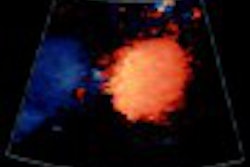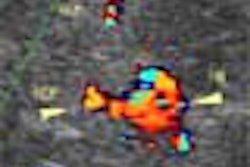Coupling fetal ultrasound and a standard blood test has the potential to dramatically reduce the number of healthy fetuses lost through amniocentesis in at-risk pregnant women, according to a study of the consequences of using genetic ultrasound in lieu of amniocentesis.
"Historically, about 10 healthy fetuses will be lost in every 1,000 amniocentesis procedures performed to test for Down syndrome," said study author Dr. Greggory DeVore, a private-practice obstetrician in Pasadena, CA. "We believe that by using genetic ultrasound we could reduce loss to less than two healthy babies."
"If all pregnant women 35 years of age and older were screened with maternal serum screening (triple-marker screening), 75% of fetuses with trisomy 21 would (still) be identified in women who were informed that their blood test was abnormal," DeVore explained in an e-mail to AuntMinnie.com. "These women would then be offered amniocentesis. The remaining 25% of fetuses with trisomy 21 would not be detected by the blood test. If the women who had ‘normal’ blood tests underwent genetic ultrasound, then additional fetuses with trisomy 21 would be identified because they would present with abnormal ultrasound findings. These women would then be offered genetic amniocentesis."
However, if these women with negative blood-test results then undergo ultrasound scanning, doctors can determine if the fetus has anatomic developmental problems that are consistent with Down syndrome.
"What we look for in the ultrasound scanning are any intracranial abnormalities," DeVore said. "We try to determine if the skin fold behind the neck is thickened. We look for any heart defects, and to see if the kidneys are dilated or if there are hyperechoic -- bright enhancements -- of the bowel."
DeVore said that if the ultrasound test did not show any abnormalities, then the risk of Down syndrome was low -- as little as 2%, he said.
On the other had, "if the ultrasound test is positive -- that is, we observe anatomical abnormalities -- we would then offer the woman amniocentesis," he said.
While amniocentesis is considered the gold standard for detecting trisomy 21 fetuses, about half the women refuse the test.
In his study, presented at the 2002 American College of Obstetricians and Gynecologists (ACOG) meeting in Los Angeles, DeVore looked at whether ultrasound would reduce the number of Down syndrome children, as well as reduce the risk of losing healthy fetuses. The research was sponsored by the Perinatology Research Branch of the National Institute of Child Health and Human Development in Bethesda, MD.
DeVore hypothesized that among a population of 100,000 high-risk women, about 784 fetuses would have trisomy 21. All those fetuses would be detected if the women had universal amniocentesis -- but that would result in an anticipated 100 lost babies.
In a second scenario, women at highest risk -- those in whom the chances of a Down syndrome baby is less than 1 in 90 -- would undergo the serum test followed by amniocentesis. He estimated that that policy would detect 86.3% of fetuses with trisomy 21 genetic defects.
But if they underwent an ultrasound exam with the blood test, the rate of detection of trisomy 21 fetuses would rise to between 93.2%-98.6%, with a sensitivity rate of 50%-90% for sonography.
"We determined that a policy of offering genetic ultrasonography, followed by amniocentesis, to patients 35 years of age and older who originally were screen-negative following triple-marker serum screening for the diagnosis of trisomy 21 is cost-effective and results in a higher overall detection rate for trisomy 21," DeVore said.
By Edward Susman
AuntMinnie.com contributing writer
July 8, 2002
Related Reading
For perinatal diagnosis of Down syndrome, ultrasound ups the odds, January 4, 2002
Measurement of fetal nuchal translucency thickness by 3-D ultrasound, January 4, 2002
Fetal nasal bone examination may improve Down's screening, November 16, 2001
Copyright © 2002 AuntMinnie.com



















